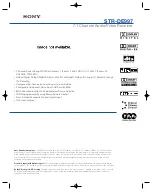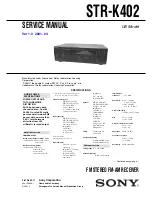
PSX-AR Manual Rev: P Software Rev: N
2
•
Wide Range of Current Trip Setting:
The breaker trip current can be adjusted over a range of
1.27 to 10.2 amperes. With additional cooling, the PSX-AR can handle up to 19.1 amperes.
Trip current values are selected by setting a CV. Certain selected values can be set by placing
jumpers on the board. Default trip current is about 4 amperes, which will work correctly for
most layouts.
•
Very Low Voltage Drop:
Total breaker on resistance is less than 0.060 ohms, so the PSX-AR
has a very low voltage drop even at high currents. Better than detectors that use a diode
voltage drop.
•
Manual or Automatic Reset:
Automatic reset: Breaker tries to reset every 2 seconds. The
reset delay can be set to a different value by changing a CV. Manual reset: Once the breaker
trips, it remains off, ensuring complete isolation of the faulty block. The breaker is reset
either by a switch or by a DCC command.
•
Power On/Off by DCC:
Turn on/off output track power with your DCC Throttle!
•
Programmable Power Up Status:
When power is applied to the layout, the PSX-AR can be set
to always turn on, always remain off [power on as needed by DCC command], or to use the
power status present when the layout was last shut down.
•
Outputs for LED Indicators:
Remote LEDs can be added to monitor input/output power status.
•
Network Feedback:
Isolated outputs designed to provide Block Occupied, Block Shorted, and
Power Status to a discrete interface for remote display or computer control. Will work with
Digitrax LocoNet, NCE Cab Bus, ESU ECoS, and Lenz XpressNet interfaces.
•
System Reset:
CV63=42 sets all CVs and addresses to original factory values.
•
Output for Audio Alert:
An audible sounder can be added to the card to provide an audible
alert if there is a short.
•
No Power Supply Needed:
The PSX-AR uses the track DCC to supply its operating power. I
draws less than 0.04 amperes.
•
Easy to install:
Board size is 5.75 by 2.75 inches with 4 mounting holes sized for a #6 screw.
•
Flash Programmable:
The PSX-AR firmware can be updated as new features become
available or if older units need to be matched to a recent purchase.
Instruction Manual Contents
A. Quick Start
B. User Guidelines
C. How to Determine Power Districts
D. PSX-AR Wiring
E. PSX-AR Reverse Section Examples
F. Terminal Wiring Descriptions
G. Terminal Functions
H. PSX-AR Accessory Addresses
I.
Programming CV’s & Values
J. CV Settings
K. Special Programming Instructions
L. Add On Circuit for the PSX-AR
M. DCC System Sequential Programming Instructions



































